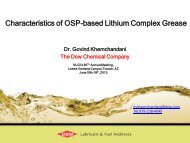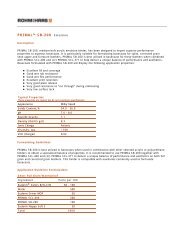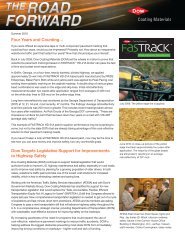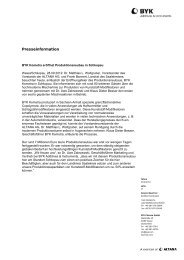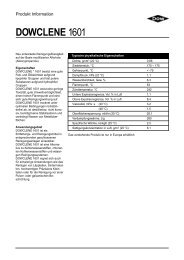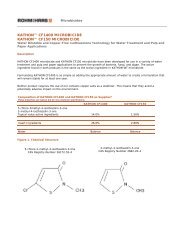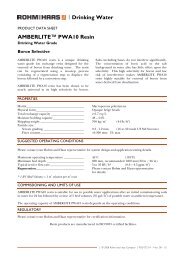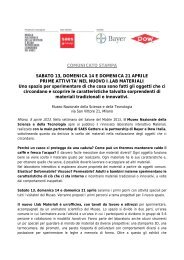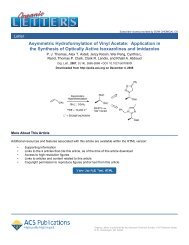Product Safety Assessment ESTASOL⢠Oxygenated Solvent
Product Safety Assessment ESTASOL⢠Oxygenated Solvent
Product Safety Assessment ESTASOL⢠Oxygenated Solvent
Create successful ePaper yourself
Turn your PDF publications into a flip-book with our unique Google optimized e-Paper software.
<strong>Product</strong> <strong>Safety</strong> <strong>Assessment</strong>: ESTASOL <strong>Oxygenated</strong> <strong>Solvent</strong><br />
unnecessary exposure. The U.S. Environmental Protection Agency (EPA) has completed an<br />
initial risk-based prioritization of the High <strong>Product</strong>ion Volume Chemicals, including the dibasic<br />
esters category. The U.S. EPA assumes that there are potential exposures to<br />
manufacturers, commercial workers and/or consumers from the use of products containing<br />
dibasic esters, with paint stripping uses presenting the potential for high exposures to<br />
individuals working in poorly ventilated areas. Available data used in the EPA’s assessment<br />
suggests a low concern for potential risk to [manufacturing] workers, but a medium concern<br />
for potential risk to commercial workers and consumers. See Health Information.<br />
• Consumer exposure to products containing dibasic esters – Dow does not sell this<br />
product for direct consumer use, but it may be used in some products, such as paint thinners<br />
and coatings, that are used by consumers. The U.S. EPA concluded that the risk for<br />
exposure to the general population from environmental releases is low. The potential risk to<br />
children as a subset of the general consumer population is considered low given that the<br />
typical consumer uses of dibasic esters do not involve children. See Health Information.<br />
• Environmental releases – Dibasic esters may be released to air by evaporation from<br />
cleaners, paint thinners and strippers, coatings and other products containing them.<br />
However, because they are highly soluble, once introduced to water, dibasic esters will tend<br />
to remain dissolved in water. Because the compounds are readily biodegradable, they will be<br />
removed by sewage treatment plants. In the event of a spill, the focus is on containing the<br />
spill to prevent contamination of soil and surface or ground water. For small spills, the product<br />
should be absorbed with materials such as sand or sawdust. Collect recovered material in<br />
properly labeled containers and dispose of it according to applicable government<br />
requirements. See Environmental, Health, and Physical Hazard Information.<br />
• Large release – Industrial spills or releases are infrequent and generally contained. If a large<br />
spill does occur, the material should be captured, collected, and reprocessed or disposed of<br />
according to applicable governmental requirements. An approved respirator with an organic<br />
vapor cartridge is recommended for emergency work. See Environmental and Physical<br />
Hazard Information.<br />
• In case of fire – Isolate the fire and deny unnecessary entry into the area. Use water spray<br />
or fog, dry-chemical or carbon-dioxide extinguishers, or foam to extinguish the fire. Use of a<br />
direct water stream may spread fire. Firefighters should wear positive pressure, selfcontained<br />
breathing apparatus (SCBA) and protective fire-fighting clothing. Follow emergency<br />
procedures carefully. See Health and Physical Hazard Information.<br />
For more information, see the relevant <strong>Safety</strong> Data Sheet.<br />
Back to top<br />
Health Information 13,14<br />
Eye contact with dibasic esters may result in irritation or corneal injury. These materials are not<br />
skin irritants. Prolonged skin contact is unlikely to result in absorption of harmful amounts.<br />
Inhalation of vapor may cause irritation of the nose and throat. Dibasic esters have very low<br />
toxicity if swallowed; swallowing amounts incidental to normal handling is not harmful. However,<br />
swallowing may result in gastrointestinal irritation. ESTASOL oxygenated solvent is not<br />
mutagenic nor is it a reproductive or developmental toxicant.<br />
For more information, see the relevant <strong>Safety</strong> Data Sheet.<br />
Back to top<br />
® Trademark of The Dow Chemical Company (“Dow”) or an affiliated company of Dow<br />
Created: March 26, 2009 The Dow Chemical Company Page 3 of 6



